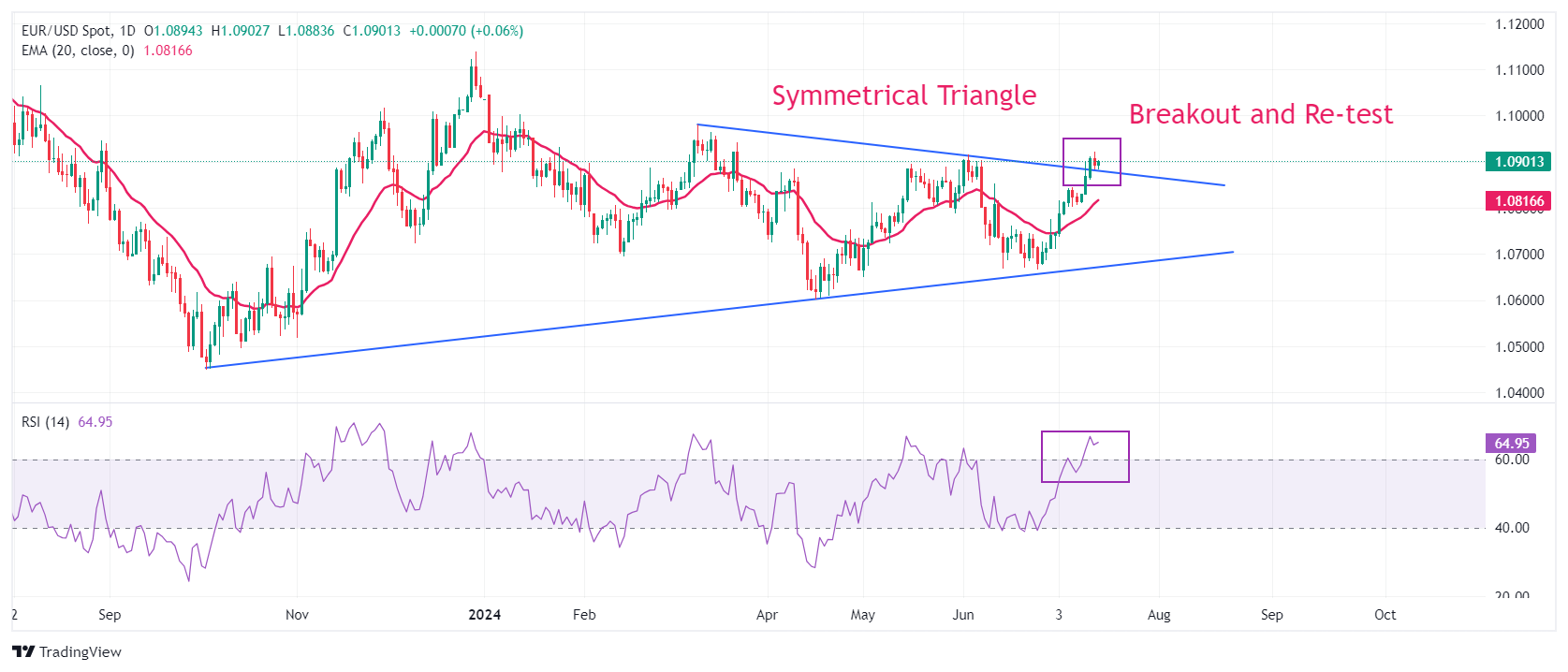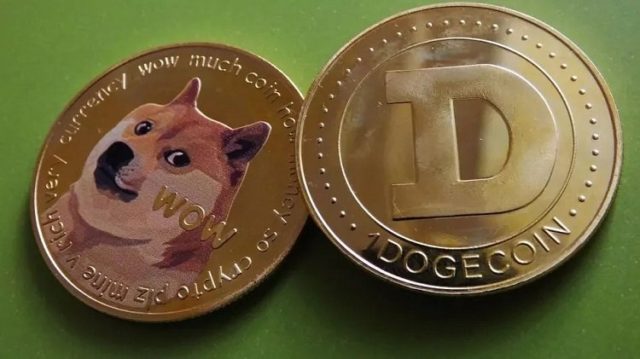- EUR/USD consolidates near 1.0900 as investors shift focus to US monthly retail sales and ECB policy meeting.
- The ECB is expected to keep interest rates unchanged.
- US monthly retail sales are estimated to have remained unchanged in June.
EUR/USD remains in a tight range near the 1.0900 round figure in Tuesday’s European session as the upward move pauses with the focus on Thursday’s European Central Bank (ECB) monetary policy meeting. The major currency pair remains broadly firm as investors expect the ECB to hold off on further rate cuts.
The ECB is expected to keep its key rates unchanged as policymakers fear that an aggressive policy easing approach could reignite price pressures again. At the last monetary policy meeting, the ECB forecast that price pressures will remain at their current levels throughout the year.
With the ECB expected to keep interest rates at their current levels, investors will be focused on clues as to when the central bank will cut interest rates again. Financial markets currently expect the ECB to cut interest rates two more times this year. The ECB is expected to make rate cuts at the September and December meetings.
On the economic data front, a sharp drop in the German ZEW – Economic Sentiment survey for July has raised concerns about the economic outlook. The sentiment data, a key measure of institutional investors’ sentiment towards economic growth, falls at a faster pace to 41.8 from estimates of 42.5 and the previous release of 47.5. In contrast, the other component, known as the Current Situation, surprisingly improves to -68.9. Economists had expected the sentiment data to have worsened further to -74.3 and the previous release of -73.8.
Daily Moves and Market Movers: EUR/USD moves sideways as USD Index stabilizes around 104.00
- The EUR/USD struggles to extend its bullish move above the more than three-month high of 1.0920. The bullish move in the shared currency pair seems to have paused for the moment as the US Dollar (USD) gains ground following Federal Reserve (Fed) Chairman Jerome Powell’s speech at the Economic Club of Washington on Monday. The Dollar Index (DXY), which tracks the value of the Greenback against six major currencies, manages to protect its immediate support of 104.00.
- In his speech on Monday, Powell acknowledged that second-quarter inflation data had increased confidence that inflation would return sustainably to the bank’s 2% target. However, Powell cited the need for more good data to build confidence before cutting interest rates.
- According to the CME FedWatch tool, 30-day federal funds futures price data show the central bank will cut interest rates twice this year and will begin reducing them starting at its September meeting.
- The latest Consumer Price Index (CPI) data for June showed that headline and core inflation slowed at a faster-than-expected pace on a monthly and annual basis. The monthly headline CPI deflated for the first time in more than four years.
- In Tuesday’s session, the main trigger for the US Dollar will be the US retail sales data for June, due out at 12:30 GMT. Retail sales data, a key measure of consumer spending that drives consumer inflation, is seen to have remained unchanged month-on-month after barely growing in May.
Technical Analysis: EUR/USD holds onto symmetrical triangle breakout
EUR/USD tests the breakout region of the Symmetrical Triangle formation on a daily time frame near 1.0880. A breakout of the mentioned chart pattern results in wider ticks and heavy volume. The short-term outlook for the major currency pair is bullish as the 20-day Exponential Moving Average (EMA) near 1.0816 is tilted upwards.
The 14-day Relative Strength Index (RSI) is moving into the bullish range of 60.00-80.00, suggesting strong bullish momentum.
Euro FAQs
The Euro is the currency of the 20 European Union countries that belong to the Eurozone. It is the second most traded currency in the world, behind the US Dollar. In 2022, it accounted for 31% of all foreign exchange transactions, with an average daily volume of over $2.2 trillion per day. EUR/USD is the most traded currency pair in the world, accounting for an estimated 30% of all transactions, followed by EUR/JPY (4%), EUR/GBP (3%) and EUR/AUD (2%).
The European Central Bank (ECB), based in Frankfurt, Germany, is the reserve bank of the Eurozone. The ECB sets interest rates and manages monetary policy. The ECB’s main mandate is to maintain price stability, which means controlling inflation or stimulating growth. Its main instrument is to raise or lower interest rates. Relatively high interest rates – or the expectation of higher rates – generally benefit the Euro and vice versa. The Governing Council of the ECB takes monetary policy decisions at meetings held eight times a year. Decisions are taken by the heads of the national banks of the Eurozone and six permanent members, including ECB President Christine Lagarde.
Eurozone inflation data, as measured by the Harmonized Index of Consumer Prices (HICP), is an important econometric data point for the euro. If inflation rises more than expected, especially if it exceeds the ECB’s 2% target, the ECB is forced to raise interest rates to bring inflation back under control. Relatively high interest rates compared to their peers usually benefit the euro, as it makes the region more attractive as a place for global investors to park their money.
Data releases measure the health of the economy and can influence the Euro. Indicators such as GDP, manufacturing and services PMIs, employment and consumer sentiment surveys can influence the direction of the single currency. A strong economy is good for the Euro. Not only does it attract more foreign investment, but it can encourage the ECB to raise interest rates, which will directly strengthen the Euro. Conversely, if economic data is weak, the Euro is likely to fall. Economic data from the four largest Eurozone economies (Germany, France, Italy and Spain) are especially significant, as they account for 75% of the Eurozone economy.
Another important output for the euro is the trade balance. This indicator measures the difference between what a country earns from its exports and what it spends on imports during a given period. If a country produces highly sought-after export products, its currency will appreciate due to the additional demand created by foreign buyers who wish to purchase these goods. Therefore, a positive net trade balance strengthens a currency and vice versa for a negative balance.
Source: Fx Street
I am Joshua Winder, a senior-level journalist and editor at World Stock Market. I specialize in covering news related to the stock market and economic trends. With more than 8 years of experience in this field, I have become an expert in financial reporting.








